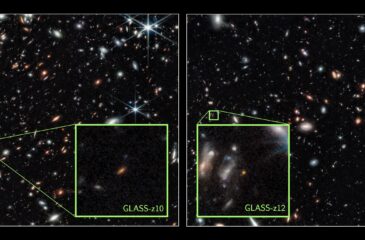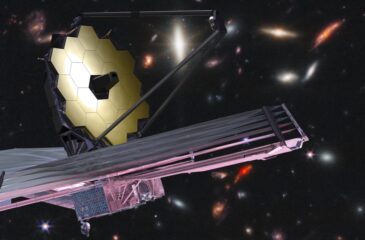Post Tagged with: "JWST"
-
Fjernest kendte galakse-kandidat opdaget af James Webb
Mindre end en uge efter at rumteleskopet James Webb blev klar til sine videnskabelige optagelser, kom de første rapporter i preprint om rekordfjerne, og dermed rekordtidlige, galakser. Endnu mere bemærkelsesværdigt er det, at galakserne ser ud til at være så tunge, at de udfordrer vores forståelse af, hvordan struktur dannes i Universet. Nu har de første to af disse rapporter gået gennem den obligatoriske fagfællebedømmelse, og gør dermed resultaterne mere robuste. Men astronomerne venter stadig på det afgørende bevis — spektroskopi.
-
Farthest galaxy candidate yet known discovered by James Webb
Less than a week after the James Webb Space Telescope was ready for science, the first reports of discoveries of galaxies at record distances and, consequently, at record-early times appeared in preprints. Even more remarkably, these galaxies seem to be so massive that they challenge our understanding of how structure forms in the Universe. Now the two first of these reports have undergone the mandatory peer-review and have been accepted for publication in the scientific journal The Astrophysical Journal Letters, substantiating the robustness of the result. However, astronomers are still waiting for the conclusive evidence — spectroscopy.
-
Galaxies at Cosmic Dawn
Since the James Webb Space Telescope began releasing its science observations last month, candidates for increasingly distant galaxies have been reported on a regular basis. In fact, the size and the number of distant galaxies seem to challenge our understanding of how galaxies form, although there are many caveats and alternative explanations. Are we facing a cosmological paradigm shift, are we misinterpreting our data, or are the more mundane reasons? Astronomers at the Cosmic Dawn Center in Copenhagen are working intensely on solving this puzzle.
-
Galakser ved Cosmic Dawn
Siden Rumteleskopet James Webb begyndte at frigive sine videnskabelige observationer i sidste måned, har vi med jævne mellemrum set rapporter om fjernere og fjernere galakser. Umiddelbart ser det ud til, at galaksernes størrelse og antal udfordrer vores forståelse af, hvordan galakser dannes, selvom der er mange forbehold og alternative forklaringer. Står vi over for et kosmologisk paradigmeskift, fejlfortolker vi vores data, eller kan der være mere banale årsager? Astronomer ved Cosmic Dawn Center i København arbejder intenst på at løse dette mysterium.
-
-
-
-
-
-



